Some games I played in 2025: Battletoads
This is a long one and I haven’t got it in me to do a preamble. I’m still on my Double Dragon kick, and it feels only natural to finally dabble in the Battletoads series as well. I honestly quite liked the look of this reboot based on its cutscenes, even if seeing them next to gameplay did one-eighty my perception, but it’s only fair to give it a swing myself.
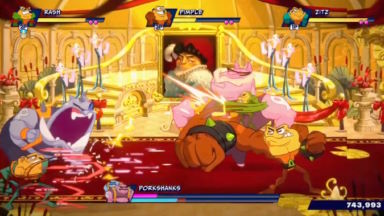
As if I haven’t talked about the genre enough already, it’s mostly a beat-em-up! In addition to strikes, launchers and dashes, you’ve got a button for transform attacks, stronger moves with greater range but more wind-up. The closest equivalent I can think of is Pocket Fighter, an attack with silly visual flair you can charge up for greater clobbering potential.
The most unique addition are perhaps the tongue mechanics, where holding the L Trigger and pressing the face buttons will perform a different function. L+Y to eat flies for health refills; L+X to close the distance between yourself and an enemy; L+B to carry yourself between hooks (see below); and L+A to spit bubblegum, pinning an enemy in place. It’s a logical extension of the Toads’ abilities, if an extremely overwrought way of implementing it.
All the Toads do feel suitably different; Pimple’s sheer brute strength is hard to pass up, while Zits is the nimble one whose transform attacks alternate between focusing on multiple directions or hitting one target repeatedly. You can tag between them using the D-Pad; it’s not nearly as dynamic as Double Dragon Gaiden‘s take on the mechanic, but it’s nice having access to all the Toads instead of being stuck with one for a whole level.
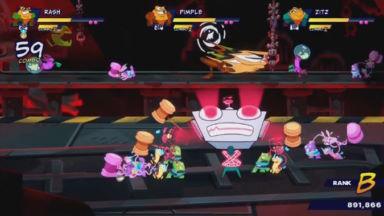
There’s no politer way I can phrase it: the levels stink, badly. They’re just long and straightforward, with no real forward momentum or dynamic setpieces to them, every level lasting ten minutes at minimum. Enemies all teleport in the exact same way, there’s no platforming or sense of verticality… there’s nothing to interact with! The closest it gets is the second stage having patches of water that’ll zap you if an enemy performs its electricity attack while standing on them. It’s all very simple.
There’s maybe only four enemy types in the game, despite all the visual variations, the most notable of which are the ones who block — it doesn’t matter how big and nasty your attack looks, nothing’s getting through unless you stop and do a charged strike (or sometimes gooping them with bubblegum). Being asked to kill my momentum for a mook who barely even fights back isn’t my idea of a good time.
It tries to spice things up with hooks that carry you between the background and foreground, but they feel superfluous — you never have to contend with enemies sniping you from the opposite tier, you can’t pull them over to your side, they’re just their own isolated arenas.
Then there’s gates that need opened with simple hacking puzzles, which are just the biggest sign of needless padding. We don’t have the time or budget to spice up the level design or gameplay loop, so please accept this jingling keychain as a distraction.
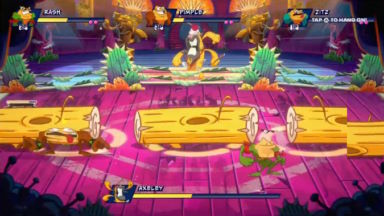
To its credit, the act of punching feels good. Strong attacks feel rightfully powerful, especially landing a killing blow with a launcher, sending them rocketing into the stratosphere. Aerial combos are particularly satisfying, especially paired with the tongue grab to pull more dudes into your reach. It’s just a pity that you’re stuck using these tricks against endless damage-spongy goons, and never against a bigger threat…!
There’s only one boss who plays by standard beat-em-up rules, and it’s the very first one — everything after that is a glorified avoid-the-obstacles challenge, waiting for your opening to land a few hits. The lumberjack boss was real frustrating in that regard, as he’s constantly dropping bombs and hazards that I thought, surely these are meant to be knocked back at him, right? Nope! “Wait your turn” seems to be the mentality behind all these fights.
Battletoads is known for its variety, and the game strives to deliver, but good grief, the turbo bike sequence is godawful and perhaps the worst introduction to a game I’ve seen yet.
It’s already off to a rocky start between its hit-or-miss delivery and its first mini-game, and now it’s tackling one of the most iconic challenges in the series… reinterpreted as an extremely slow and drawn-out test of endurance.
It takes its sweet time rising in difficulty, with only the cumulative risk bonus of avoiding obstacles at the last second enough to faintly entice me. I don’t know anyone who was won over by the bizarre comedy ramblings of the turbobike rental guy.
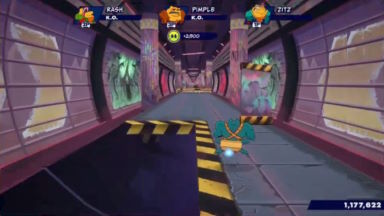
It’s likely this is the first stage you’ll discover the game’s collectibles ((not even given a name, they’re just called collectibles, in another stint of self-aware humour) since they’re hard to miss. Playing for what feels like five minutes and getting the first one, revealing there’s four more to collect and this is only the beginning of the level… it’s been a while since a game made my heart sink like that. The stage lasts 7 minutes (provided you don’t screw up), and sets the bar for every subsequent genre shift going on far too long and wearing out its welcome.
I do want to stop and say that the game’s visuals are impressive. All the sprites are fully hand-animated, buttery smooth and oozing with attitude, making the most of its abstract cartoon sensibilities between the Toads’ transformative attacks and the sheer oddball nature of the enemies you encounter.
The backdrops are a blend of lush painted 2D assets against a 3D perspective, and are perhaps the most stunning depiction I’ve seen of a living cartoon. While the game’s use of depth isn’t all it’s cracked up to be, simply scrolling through a level and seeing what looks three-dimensional, but is actually a billboard skewed in just the right ways, shows the synergy of its artists and their tools.
I found the cutscenes a lot of fun, honestly. Its Flash-style tweening obviously isn’t as dynamic, but its rapid-fire dialogue and irreverence kept me entertained, and it’s something that’d feel right at home on Cartoon Network. It’s just when it has to mesh with gameplay, it kind of falls apart.
After the zippy and banter-filled cutscenes, you’re then chucked into gameplay that’s deathly slow and shockingly quiet. The mini-games are often used to punctuate a joke, but the hard cut to black and fifteen seconds of loading do wonders on making it bomb.
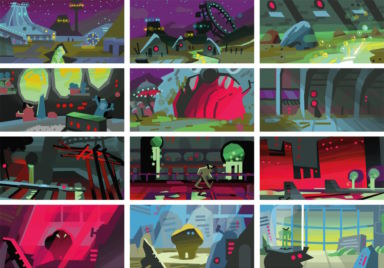
Dark Horse Publishing’s The Art of Battletoads is largely about its visual design, but also details the “colour script,” essentially storyboards to set the mood and flow of a level, how one backdrop leads into another. It’s a fascinating insight and an interesting way to structure their levels… if an unfortunate demonstration how the visuals came first, not so much what these locales would offer in the way of challenges, interactive landmarks, etc. It also does a better job showing landmarks that the Toads comment on in-game than, well, the game itself.
Designer AJ Grand-Scrutton expressed that the lesson they learnt after Battletoads (full interview here) was “scoping”. They were reluctant to scale down their vision during pre-production and tried to juggle too much, until they had to cut stuff mid-development.
It’s pretty obvious, unfortunately! Setpieces that are sorely lacking in pomp and circumstance. Grand plans established in the cutscenes that are resolved in non-sequitur mini-games. Outright acknowledging what a wet fart their solutions are in dialogue.
The entire third act is an hour-long intermission where Rash and Zits partake in meaningless space battles, while Pimple goes on a quest for inner peace in the form of extremely mundane platform puzzles, stringing out its most asset-light modes as far as it can.
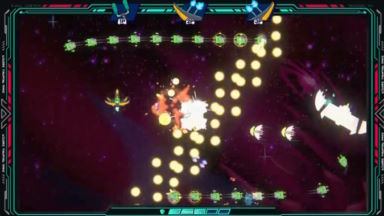
It leans on being a party game to get the fullest from some of its setpieces. Mini-games bounce between characters so every player has their own QTEs to respond to. The aforementioned space shooter sequence is designed so every player controls a separate part of the ship, and the subsequent hacking mini-game is split across each player’s inputs, requiring coordination to do it in the right order. None of this really transfers when you play the game solo, though, so I can only imagine the fun I’m missing by the getting the hassle-free version.
Assuming I’ve published these in the right order, it’s not far off from Mighty Morphin’ Power Rangers: Rita’s Rewind where people perhaps expected a beat-em-up first and foremost, but what the game delivers is more of a grab-bag. It sometimes lets you beat up things, but by and large it’s about mini-games, genre shifts, and being a cartoon with some degree of interactivity.
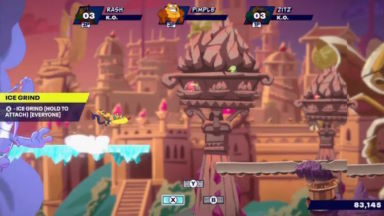
It’s a noble and ambitious effort, one that really shines in its visual fidelity and commitment to the bit. If its gameplay was tightened up so you weren’t left with minutes of awkward silence between comedy skits, I’d honestly say that’d be a step in the right direction! (It’s shocking to play a modern game that isn’t gabbing incessantly during the action, to be honest…!)
… but I have to wonder if being associated with Battletoads, and all the baggage that comes with it, is what sours the experience. The farther it gets from the source material, the more it feels like they enter their comfort zone. Act 3 effectively ping-pongs between Geometry Wars and a more tranquil Donkey Kong Country — they’re pretty light on assets and variety, but they play nicely for what they are. They’re just the very opposite of what I look for from Battletoads!
And when it does dabble in more familiar territory, it’s hard not to make unflattering comparisons. More than just its variety, Battletoads was fast — thrusting you into new challenges on a whim, making seamless transitions between brawling, platforming, abseiling, turbo-biking, and goodness knows what else. If I’m stuck in one challenge for ten minutes, it’s because I’m not doing good enough! If I’m doing the same thing for a quarter of an hour in this game… well, that’s it working as intended, sadly.
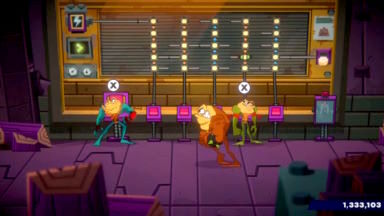
I don’t like to pooh-pooh reboots and revamps. Any new instalment under new management is always a tricky thing to address, both as a creative and as the audience, and in this age of ironic fandoms, how do you even know if there’s a legitimate interest or not?
I do respect the hustle, as it does seem like a freeing gig: when Microsoft’s footing the bill and otherwise has no stake in the IP, it becomes an outlet for artists to go nuts above all else, and what they present is creative and full of strange, offbeat charm.
Its sense of humour feels like a cartoon writers’ room gone mad, full of bizarre notions and rambling discussions. The aesthetic is truly just the artists and animators having fun; character designs defined by weird, unorthodox shapes, mostly notably in the Dark Queen’s toy-based minions. Seeing these cacophonies of contours move and attack is a lot of fun… if difficult to parse.
Which feels emblematic of the backlash. I can’t tell what I’m looking at. I don’t know what I’m fighting. None of these grunts have voices, and it’s only in the cutscene after this stage do I even get context for who they are, by which time I’m no longer fighting them. I’m not conditioned to become invested in them as characters, or in the world around them…!
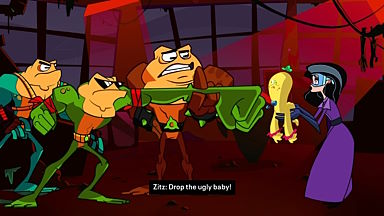
And that’s kind of the crux of it. It’s no longer recognisable as Battletoads! The Toads and the Dark Queen are the only hold-overs, and they feel like outliers among these freaks and aliens — which is thematic, given the plot and all, and I do enjoy their characterisations, but it effectively jettisons all the traits and iconography the series was known for.
The ‘self-serious to the point of self-parody’ macho stylings are gone, as are its bevy of gross and nasty animal freaks. It’s a true disappointment for hyper-furs, but fans of geometric mutants who talk like gay podcasters are in luck.
While it can be extremely hit-or-miss, I do enjoy its sense of humour — it’s let down by the aforementioned pacing issues, and, well, it’s such an odd vibe to pair with Battletoads.
It’s not exactly building upon the foundations of the series. It’s more like an interpretation — and that’s neat! It’s an interesting way to approach a franchise that’s this close to dead and buried. I’ve seen a post defending the reboot, citing the easier difficulty among its merits, and I do think allowing players to get more than three levels into a game and rewarding them with story is a good thing.
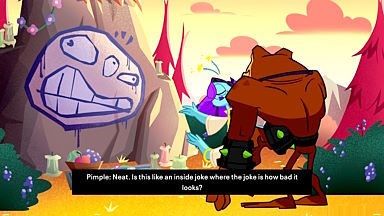
It’s just… well, it doesn’t resemble what we know. The speed, the attitude, the lore (such as it is), it overtly expresses every desire to do something totally different instead. While I credit that to a team of creatives wanting to do their own thing, I can see why some folks might view it as an insult. Why make a Battletoads game that wants nothing to do with being Battletoads?
And following that train of thought, you could ask: what audience is it aiming for? Its self-deprecation sat wrong with hardcore fans, and its kookier humour seemed an odd fit for the ironic crowd.
The remixed combat mechanics appear like an effort to spice things up, but they come across as needlessly fiddly more than anything, an attempt at complexity that’s unnecessary for how simple the fights are (going from a 2-button game to using every single input in conjunction with one another is a bit of a leap…!). Whether you view it as a beat-em-up first or a grab-bag, neither label is ever truly met satisfactorily.
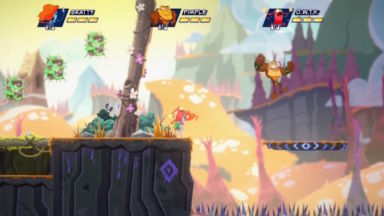
Looking at its character designs in isolation on The Spriters Resource… honestly, it feels like it wants to be a Rayman game more than anything. Seeing how the studio have more pedigree in that genre, recently releasing co-op platformer Disney Illusion Island, it feels a good fit for them! It’s not like Ubisoft’s doing anything with the bloke. How has there not been a competing spiritual successor by now…?
Which might be how Battletoads ought to proceed after this, oof. I respect its chutzpah, and truly laud the work of its artists and designers. It’s a stonkingly beautiful game, one that clearly shows the effort and budget put into its art design; do give The Art of Battletoads a skim if just to appreciate the design work. (and also bemoan the stuff that never made the cut — so much functionality that’d earn its keep if they kept the challenges intended for them…!)
But if it’s not what the people want, it almost doesn’t matter what it’s trying to be or the work that went into it. It’s a bummer! Battletoads and Bubsy became banners of ironic gamer humour because it costs nothing to make jokes, in a sense. Trying to bank on that ‘engagement’ and charge $20 minimum is a very different story, and I think that’s always going to be met with suspicion.
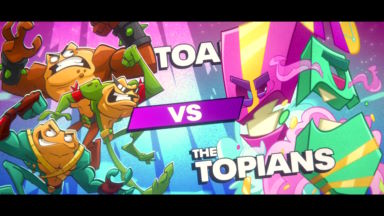
I have to wonder if targetting a gamer audience instead of the cartoon crowd was the wrong move. A game has so many expectations placed on it, but releasing some animated shorts to show the series isn’t dead might be received more amicably.
It does feel like a “damned if you do, damned if you don’t” situation, though, and I’ll have another post this month to ramble about its fumblings. The game’s a charming curiosity, but as something to play for fun or have faith in the series’ future, it’s a bit hard to defend…!

They battered the battertoads Wait, what do you mean they’re called BATTLEtoads?